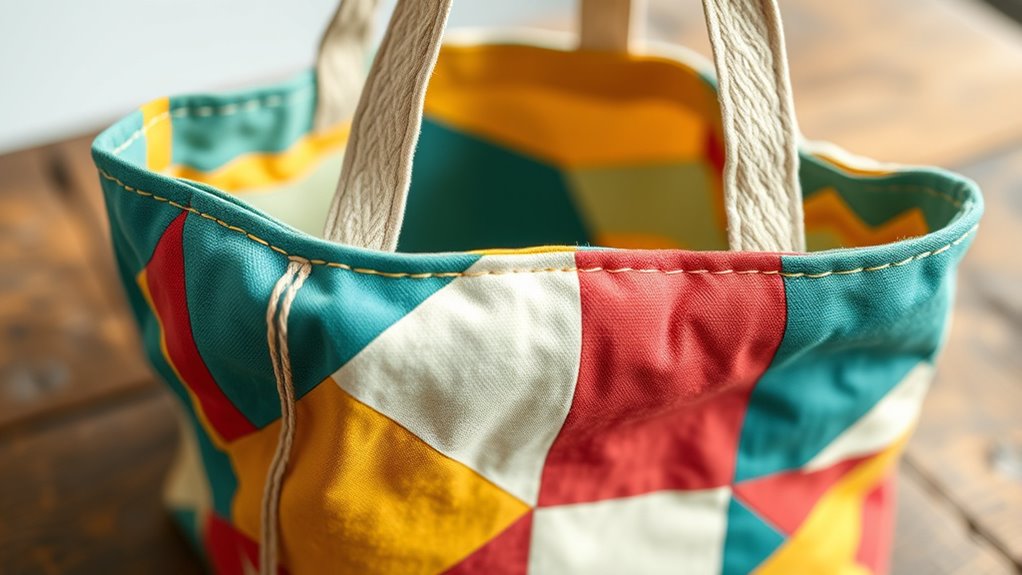To sew a reusable fabric tote bag, start by choosing sturdy fabrics like canvas or denim for durability. Pre-wash your fabric, then cut pieces accurately. Sew the sides, bottom, and handles securely, reinforcing stress points with backstitches. Add topstitching for a finished look and extra strength. Use interfacing inside for structure if needed. With attention to detail, you’ll create a practical, eco-friendly bag. Keep going to discover more tips to perfect your tote!
Key Takeaways
- Choose sturdy, heavy fabric like canvas or denim, and pre-wash to prevent shrinkage before cutting.
- Measure and cut fabric accurately, reinforcing with interfacing or fusible fleece for added structure.
- Use a straight stitch with reinforced seams at stress points like handles and corners for durability.
- Attach handles securely with topstitching and sew side seams, then turn the tote right-side out and press.
- Add personal touches such as decorative stitching or pockets to customize and enhance the tote’s longevity.

Ever wonder how to create a practical, eco-friendly accessory that you can use again and again? Sewing your own reusable fabric tote bag is a simple, satisfying project that lets you customize your carryall while reducing plastic waste. The first step is choosing the right fabric, which plays a vital role in the bag’s durability and look. When selecting fabric, opt for sturdy materials like canvas, denim, or heavy cotton, as these hold up well over time and can withstand daily use. Consider the weight and texture—heavier fabrics tend to be more robust, but lighter ones like quilting cotton can work if you reinforce them with interfacing. Think about your style too; printed or solid fabrics can give your tote a unique personality, and choosing eco-friendly or organic options aligns with the sustainable goal of the project.
Once you’ve picked your fabric, it’s important to keep sewing tips in mind to guarantee a successful project. Start by pre-washing your fabric to prevent shrinkage and to remove any finishes that might interfere with sewing. Cutting your fabric accurately is key, so measure twice and cut once, using sharp scissors or a rotary cutter for clean edges. When sewing, use a straight stitch and set your machine to a medium stitch length—around 2.5mm—so your seams are strong yet flexible. To reinforce stress points, like the handles and corners, double-stitch or backstitch to secure the seams. For added durability, consider sewing a strip of interfacing or fusible fleece to the inside of the fabric before assembling the bag. This extra step gives your tote more structure and longevity. Additionally, understanding the importance of proper storage solutions can help keep your finished tote in great shape over time.
Handling the fabric carefully during sewing is essential. Keep the fabric flat and smooth to avoid puckering or uneven seams. If working with thicker fabrics like denim, use a needle suitable for heavy-duty work—usually a size 90/14 or 100/16—to prevent skipped stitches. When attaching handles, make sure they’re securely sewn with reinforced stitching, as this is where the most strain occurs. Topstitching along the upper edge of the tote and handles not only adds a finished look but also strengthens the seams. As you sew, don’t rush—taking your time ensures neat, professional results. Once assembled, turn your tote right-side out, press the seams flat, and add finishing touches like a decorative stitch or a small pocket. In just a few steps, you’ll have a stylish, eco-friendly bag ready to replace plastic ones and make a positive impact on the environment.
Frequently Asked Questions
What Fabric Is Best for Durability and Eco-Friendliness?
You should choose fabrics like recycled fabrics and organic materials for durability and eco-friendliness. Recycled fabrics, such as recycled polyester or upcycled cotton, are great because they repurpose waste and reduce environmental impact. Organic materials like organic cotton or hemp are also excellent, as they’re grown without harmful chemicals and are strong enough for daily use. These options help you create a sturdy, eco-conscious tote bag that benefits the planet.
Can I Customize the Tote With Pockets or Embellishments?
Like Picasso with a blank canvas, you can easily customize your tote with pockets or embellishments. Use embellishment ideas such as embroidery, appliqué, or fabric paint to add personality. Personalization techniques like sewing on contrasting fabric patches or attaching charms make it uniquely yours. Feel free to experiment with different textures and colors—your tote can become a reflection of your style and creativity, making it both functional and a statement piece.
How Do I Reinforce the Handles for Heavy Loads?
To reinforce the handles for heavy loads, start with sturdy handle attachment. Use reinforcement techniques like double or triple stitching where the handles meet the bag. You can also add extra fabric or interfacing at the handle attachment points for extra strength. Make sure your stitches are tight and secure, and consider using rivets or bar tacking for added durability, ensuring your tote handles can handle heavier loads without tearing.
Is There a Recommended Sewing Machine Type for This Project?
You should choose a sewing machine with strong sewing machine features, like a heavy-duty motor and adjustable stitch settings. Suitable machine types include a heavy-duty or industrial sewing machine, which handles thick fabrics and reinforced seams better. Look for one with multiple stitch options, adjustable speed, and a robust build. This guarantees you can sew sturdy handles and seams, making your tote bag durable enough for heavy loads.
How Do I Care for and Wash the Finished Tote?
To care for your tote, wash it in cold water on a gentle cycle to preserve the fabric. Use fabric softening to keep it soft and stain removal to tackle any spots. Avoid bleach, which can damage the material. After washing, air dry or tumble dry on low heat. Regular care keeps your tote looking fresh and durable, ensuring it remains a reusable, eco-friendly choice for everyday use.
Conclusion
Now that you’ve mastered the method of making a marvelous, manageable, and eco-friendly tote bag, you’re ready to reuse, reduce, and rock your new creation. With a little bit of patience and plenty of practice, you’ll produce perfectly pretty, practical pieces every time. So go ahead, gift yourself a great gift, and get going on your gorgeous, green, and gratifying project. Remember, your reusable tote is not just a bag — it’s a beautiful badge of your brilliant, biodegradable efforts!









